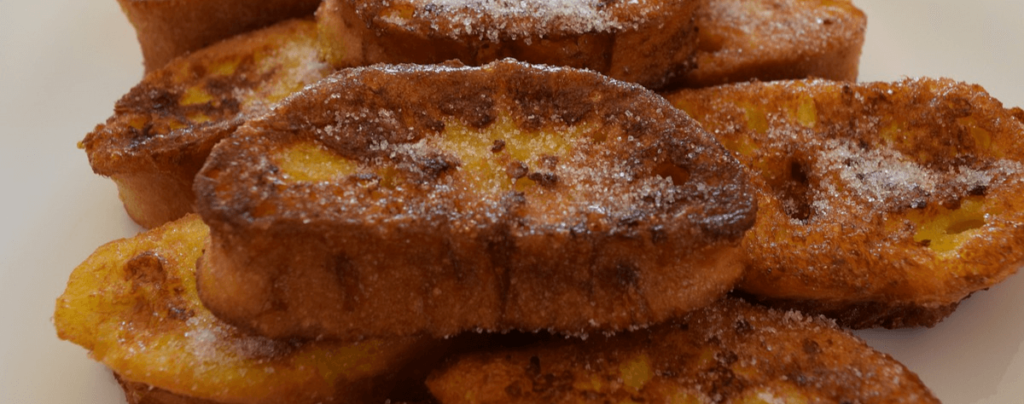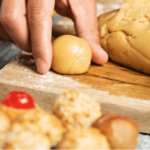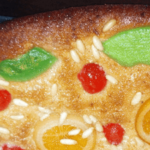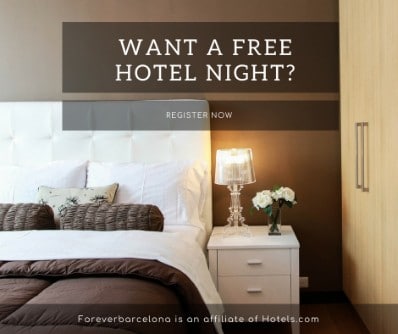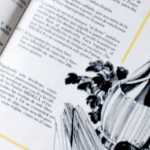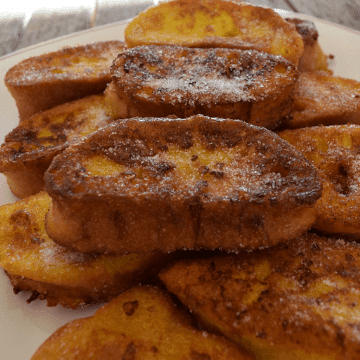
Recipe for Torrijas, the Spanish French Toast
WHAT ARE SPANISH TORRIJAS?
Torrijas (pronounced “toh-ree-has”) are a Spanish sweet treat similar to French Toast and Bread Pudding, but Spanish style. It’s basically old bread dipped in flavored milk, then coated in egg and deep-fried. But it admits some variations that we’ll be discussing in this post.
It is traditionally eaten in Lent and Easter, although it’s not unusual to see it “outside of season”. Mostly served as dessert, it also works as breakfast or late-afternoon snack.
It is very popular in Madrid, where it is sold in many bakeries and cake shops such as Horno San Onofre, El Riojano, Antigua Pastelería del Pozo or Manacor). In Seville they are often soaked in wine rather than milk, or sprinkled with chocolate like the ones in Los Angelitos.
In Barcelona it’s also called “Torrades de Santa Teresa” (because they were made by Carmelite nuns in their convents). They are not as easy to find, but they serve them in some tapas restaurants such as Cerveseria Catalana, gastrobars such as Gresca, and they are sold in Macxipan bakeries every Tuesdas, Thursday and Saturday of Lent and Easter.
Spanish Torrijas vs French Toast
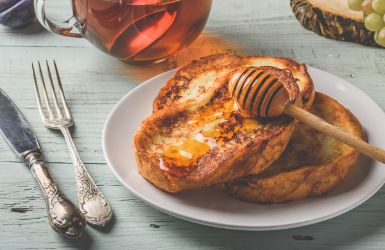
Often Spanish Torrijas are called Spanish style French Toast. But the truth is that even if they look similar, the way to make them differs in 2 key points. When Pain Perdu (that's how French people call French Toast in French) is fried in butter, Spanish Torrijas are deep fried in olive oil.
Also, in French Toast milk and eggs are combined before adding the bread. Instead, the Spanish Torrijas recipe asks to first drench the bread in milk and only then coat them in egg.
I’ve also noticed that often the crust is removed for French Toast, which is not necessary for Torrijas. And finally, there’s a version of Torrijas that involves wine or liquor – which definitely doesn’t happen in France.
Other people compare the Spanish Torrijas recipe to bread and butter pudding. And while again, the texture might be similar, the recipe for Torrijas doesn’t include raisins, and they are deep fried, not baked. So they are not bread pudding either.
Torrijas history and origins
From the 1300’s the recipe starts appearing in cookbooks all over Europe, and the first mention to “torrejas” in Spain dates from a Christmas song from 1496. And it’s precisely in the middle ages when the history of Torrijas gets juicy. Spain was a melting pot of cultures, and they all had it in their cookbooks:
The Moorish had their zalabiyya, an early version of Torrijas that were a sort of fried brioche sprinkled with honey. The Sephardic Jews called them “revanadas de parida“. It translates as “labor slices”, and it looks like they were given to mothers after giving birth because they believed that the milk on the Torrijas would stimulate the mother’s milk production for nursing.
Christians also gave it to expecting mothers, mothers in labor and mothers in post-partum. The ideas was that such a calorific treat would help them restoring their energy and nutrients. They even gave it to ladies seeking to get pregnant because egg was supposed to stimulate fertility!
Also, there’s who thinks Torrijas sort of look like baked meat, so people would eat it as a tasty form of self-delusion when they craved it. And other state that in Easter and Lent there was a lot of leftover bread because they couldn’t use it to mop up the meat juices from the plates. So Torrijas came to rescue to avoid food waste.
And then, there’s the symbolic meaning of it: just like in mass Christians consider bread as the body of Christ and wine is His blood… Guess what was used to make Torrijas? Bread of course. And (cheap) wine to soak it, when milk wasn’t as readily available as it is now thanks to refrigerators!
Some go as far as to say that stale bread is “dead” bread, that is resuscitated thanks to the combination of milk, eggs and fire. Well, maybe it’s a bit too much, but hey! Who am I to judge what people might believe?
Torrijas ingredients
- 1 loaf of bread
- 1 liter (4 cups) of milk
- 1 cinnamon stick
- 1 lemon rind
- 1 orange rind (optional)
- 200gr (1 cup) of sugar
- Optional spices (see below)
- 4 to 6 egggs
- 1 bottle of olive oil
- Your favorite toppings (see below)
This was just a quick list for your convenience, but next you’ll see some very interesting comments about how to choose your ingredients and what to take into account.
1
The bread - 1 loaf
What type of bread works best to make Torrijas?
Choose a loaf of white bread (not whole-grain, no pumpernickel). The point is to find one that is thick enough but still has small air holes to soak up the milk and retain it. If the holes are too big, like in some artisan bread, the liquid won’t stick to it.
Traditionally we use a baguette type of loaf, but for a more gourmet finish you can use brioche or challah. And if you don’t have anything else, Pullman sandwich bread works fine as long as it isn’t sliced too thin.
How stale does it need to be?
To stale or not to stale, that is the question! And the answer is: whatever you have at home will be fine. It can work even with fresh bread! So then why all this fuss about using old bread? Well, first of all, to avoid food waste.
But then I found this gem of a post where a food blogger took the time to test different types of bread and “stale” time. And his conclusion is that the older the bread was, the faster it soaked. But eventually “there’s only so much liquid that a piece of bread can absorb” – which makes a lot of sense, BTW. So the end result was pretty much the same.
Some people suggest to toast or put fresh bread in the oven if you don’t have any old bread at home. But he warns that since the bread will just be slightly dehydrated rather than truly stale, your torrijas are likelier to be more delicate and harder to handle after soaking.
2
The Liquid - 1 liter / 4 cups
Torrijas de Leche recipe
“Leche” means milk in Spanish. So “torrijas de leche” are the traditional Spanish Torrijas recipe that calls for milk. You’ll be using about 1 liter or 4 cups of it. But have more on hand just in case your bread can soak in more than that.
Does it have to be cow milk? Well, definitely don’t use goat – it’ll ruin the dish. If you can’t do lactose or don’t do animal products, feel free to use your favorite vegetable milk. The flavor and texture might be a bit different to the “real thing”, but it shouldn’t be a big deal.
Can it be skimmed milk? Well, sure. The flavor won’t be the same, but I’m not going to tell you how to run your kitchen. However… This is a high-calorie dish. Do you know those people that order a double brownie for desert and then ask for sweetener for their coffee? That.
Torrijas de vino recipe
If you decided to go for wine torrijas (“torrijas de vino”), here the recommendations differ. Some say to go ahead and use an entire liter / 4 cups of sweet white wine. The alcohol is supposed to evaporate with the heat anyway…
But if that sounds like too much booze for you, other recipes say to dilute it in water or adding about 1/3 cup (80ml) to the milk after having flavored it (see next section).
Does it have to be sweet white wine? Some people do red wine instead. And other even suggest dry sherry or liquor. Feel free to experiment!
3
Flavoring
And if you feel creative (and don’t care much about being “authentic”), consider adding some cardamom pods, maybe a clove, or a star anise… Not “traditional”, but fun.
4
Anything else?
- 4 to 6 Eggs. I’d recommend to start with 4 but have a couple more at hand in case you run out of them while coating.
- A bottle of olive oil. You don’t need to use up the whole: pour enough in the skillet so the oil covers the bottom half of the slices. When you reverse the slice, the other half will be covered.
- Toppings. That’s really up to taste. It can be just sugar. Or cinnamon powder. Or honey. Or syrup. Or the leftovers of the flavored milk (cinnamon stick, rinds and spices previously discarded). Or even some melted chocolate. You pick!
Spanish torrijas recipe
5
Recipe Method
Make the flavored milk
- Put the milk, sugar, rinds, cinnamon stick and optional spices in a pot, stirring to dilute the sugar. Keep an eye on it and take it off the fire right before it boils (boiling milk can quickly spill all of a sudden).
- Filter the milk to discard the solids and let it cool off for at least 10 minutes. It it’s too hot, the bread might dissolve upon soaking.
Bread soaking
- Arrange the bread slices on a deep tray and pour the milk over them.
- Let the bread soak for 10 seconds or so, then turn the slices around so they get soaked from the other side as well. The goal is that the inside gets mushy and custardy, whereas the crust looks wet but not soggy. Some believe you need to soak it for much longer, even hours, so the Torrijas are as juicy as possible. But as we discussed before, bread can only soak in as much milk…
Deep frying
- Heat the olive oil in a large frying pan so you can do a batch of several torrijas in one go. It has to be hot, but not smoking: just like for an omelet, a drop of egg should bubble immediately in contact with the oil, but not burn.
- Whisk the eggs. This is the step that makes the whole difference with French Toast: not adding the egg to the milk.
- Take one slice, let drain the excess of milk a bit before dipping it in the egg, first one side, then the other, then the crust around it if not coated.
- Lay the slice in the pan, then repeat with more slices until the pan is full without overlapping.
- It should take 1 to 2 minutes for the slices to start looking golden in the bottom. Turn them around.
- When both sides are golden, remove the slices from the pan and place them on a platter lined with towel paper to remove the excess of oil.
- Keep doing batches of slices until you are done.
Last touches
- Sprinkle with your favorite topping and serve warm.
- IDEA: Sprinkle them with sugar and use a blow torch to caramelize the tops!
- ANOTHER IDEA: If your topping is liquid like milk leftovers or syrup, and you have enough of it, pour over the torrijas and let it soak for a while (even overnight).
6
What to do with the leftovers
Spanish Torrijas were born as a recipe to avoid food waste. So it makes sense to finish this post giving you some tips for what to do with any leftovers. Either ingredients or torrijas. Nothing goes to waste!
Letftover ingredients
- Left over milk and eggs? Mix in and heat until it starts thickening and becomes a sort of creme anglaise that you can pour over the torrijas as a topping.
- Or you can refrigerate the drained milk and drink it as a Summer refreshment. It’s actually very similar to Spanish “leche merengada”.
- You can make a sweet omelet with the leftover eggs.
- And don’t forget it is fine to reuse olive oil. Just strain it and store in a specific grease container (do not mix with unused oil).
Leftover Torrijas
- Spanish torrijas taste even better the next day! Keep them in an air-tight container at room temperature. You can eat them just like that, no need to reheat them! Or you can keep them in the refrigerator, too, but then you might need to warm them up before eating.
- Do not warm them up on the microwave: they get rubbery! Instead, use an oven toaster or heat them on a pan at low temperature.
- You can freeze them too, but is that necessary? Thawing them will be almost as much work as making them again from scratch. Just make a new batch next time!
This is how to make torrijas at home! Enjoy!
Marta
MORE BARCELONA TIPS FOR YOU:
SHARE WITH YOUR TRAVEL MATES
RESEARCHING FOR A TRIP IS TIME-CONSUMING…
Need more inspiration?
Our 100% FREE Barcelona Collection will give you everything you need to organize the trip of your lifetime to Barcelona.
BEST INSIDER TIPS FROM THE PROS!
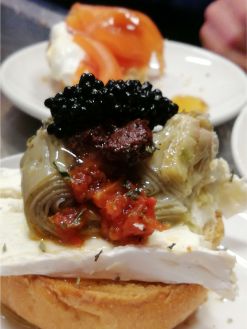
Last update on 2024-04-26 / Affiliate links / Images from Amazon Product Advertising API

